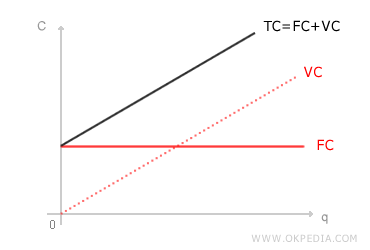Fixed Costs
Fixed costs are the portion of total costs that remain unchanged regardless of production levels. They are typically tied to the infrastructure and capacity of a business, such as production facilities, machinery (including depreciation costs), and buildings. Within a certain range, fixed costs are independent of output: whether a company produces a little or a lot, its facility capacity stays the same, and these costs must be covered either way. If a company wants to scale production beyond its current capacity, it must invest in additional facilities or equipment.
In the graph below, fixed costs are represented by the horizontal line (FC). Since they do not fluctuate with production volume (q), the fixed cost curve is a straight, parallel line along the x-axis. The other two lines represent variable costs (VC) and total costs (TC).

For instance, if a company scales back production due to a sudden drop in market demand, it must still pay for rent, facilities, and machinery in full. Likewise, if demand unexpectedly surges, the company can increase output only by using more variable inputs (such as raw materials and labor) without altering its fixed production capacity (technology). Expanding capacity requires time and investment. Even if a company decides to increase its production capabilities, it may take years to build new facilities or acquire additional machinery. That’s why, in the short run, fixed costs are considered constant. However, over the long run, even fixed costs become variable, as businesses can upgrade their technology and infrastructure to adapt to market conditions.
